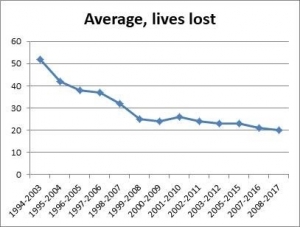


(Posted on 14/05/18)
INTERCARGO’s latest Bulk Carrier Casualty Report, which provides an analysis of bulk carrier total losses between 2008 to 2017, has been submitted to the International Maritime Organization (IMO) for the consideration of the Member States, Non-Governmental Organisations and other interested parties.
Between 2008 and 2017 there have been fifty three total losses of bulk carriers of 10,000 tonne deadweight and above with the reported loss of 202 seafarers.
Analysis of INTERCARGO’s casualty records from 1994 to the present day indicates a gradual improvement over the years in terms of numbers of lives and ships lost.
The bulk carrier industry recognises the many contributing factors to this safety improvement, which include the introduction of adequate safety requirements by the IMO flag States, the role of IACS, PSC regimes and the best practices and large investments by the bulk carrier industry.
There is no room for complacency and further work needs to be done in order to continue the trends with the ultimate goal of no lives or ships lost.
In March 2017, the sinking of M/V Stellar Daisy, carrying iron ore, resulted in the tragic loss of 22 seafarers. While the Search And Rescue (SAR) efforts in response to this sinking are to be praised, in its aftermath the shipping community should be concerned about the non-availability of sufficient SAR capabilities in the vicinity of busy shipping lanes around the world and revisit this issue.
In October 2017 the sinking of M/V Emerald Star, loaded with nickel ore, claimed the lives of 10 seafarers. The industry expects that the full investigation reports will provide answers and highlight the lessons to be learnt from these losses.
The Bulk Carrier Casualty Report 2017 again highlights that cargo failure, including moisture related cargo failure mechanisms, is one of the greatest concerns for the safe carriage of dry bulk over the past 10 years and is likely the cause of the loss of 101 seafarers’ lives and 9 vessel losses.
The incident onboard the 57,000 dwt MV Cheshire in August 2017 involving high temperatures in the cargo holds and the release of gases from the cargo again raised serious concerns with the carriage of ammonium nitrate based fertiliser. The shipping industry welcomed the issuance of the IMO circular CCC.1/Circ.4 on “Carriage of Ammonium Nitrate Based Fertilizer (non-hazardous)” on 22 Sept 2017; however bulk carrier owners and masters are expecting prompt and clear mandatory safety requirements to avoid recurrence of the M/V Cheshire and M/V Purple Beach incidents.
Anemoi Marine Technologies, the UK-based leading designer of Rotor Sails for wind-assisted ship propulsion... Read more
Helm Operations has announced that nine electronic record books within Helm CONNECT Logbook have been... Read more
International maritime welfare charity Sailors’ Society has announced a significant expansion... Read more
NORDEN has signed a two-year Contract of Affreightment (COA) with Enviva to transport a significant... Read more
Algoma Central Corporation has reported its results for the three and nine months ended 30 September... Read more
Damen Shipyards Group has unveiled the latest platform in its successful cargo vessels portfolio. The... Read more
Wallem Group, a leading global maritime partner, is celebrating the centenary of moving its headquarters... Read more
The International Association of Dry Cargo Shipowners (INTERCARGO) is marking its 45th anniversary in... Read more
Net profit for the Group amounted to USD 26 million (DKK 166 million) in the third quarter of 2025,... Read more
ClassNK has released 'Guidelines for Onboard CO2 Capture and Storage Systems (Edition 2.0)' first in... Read more